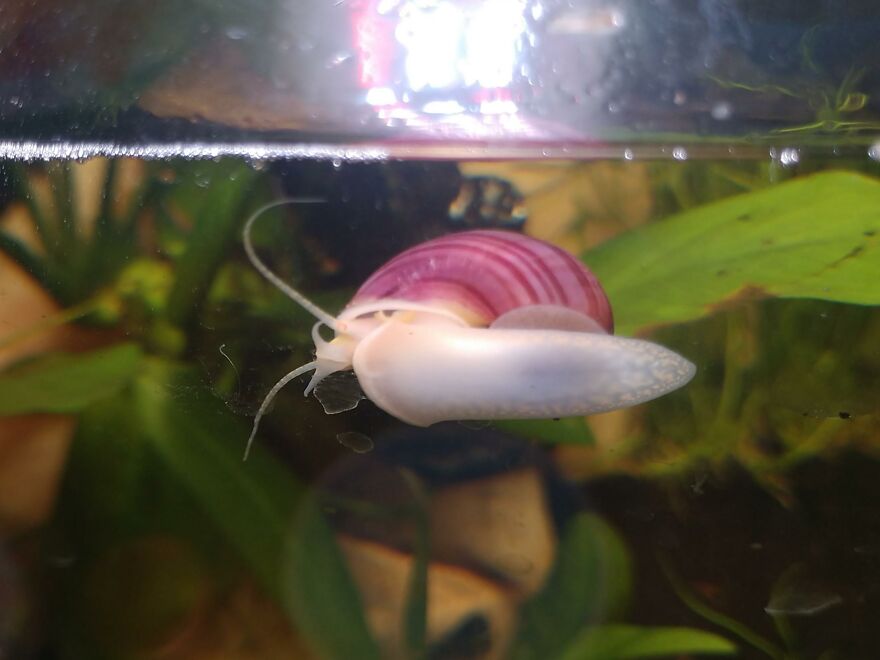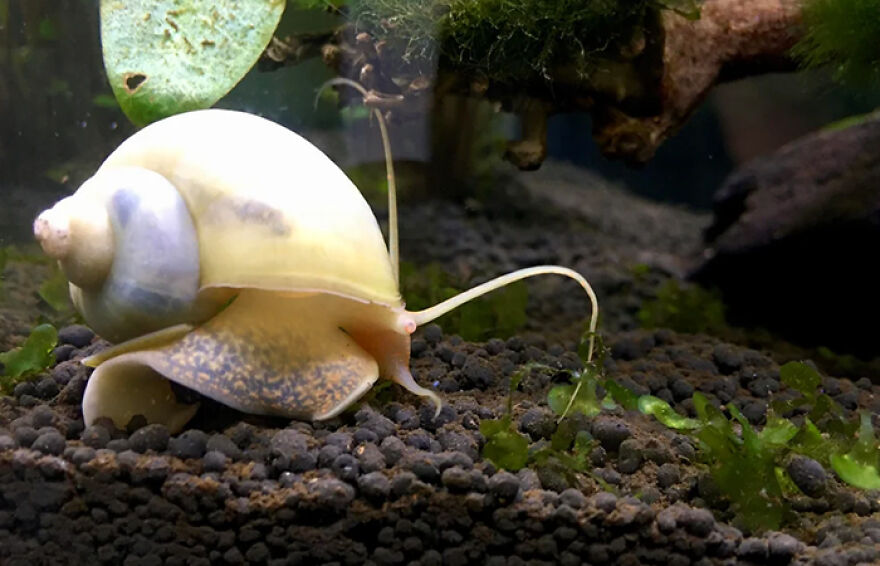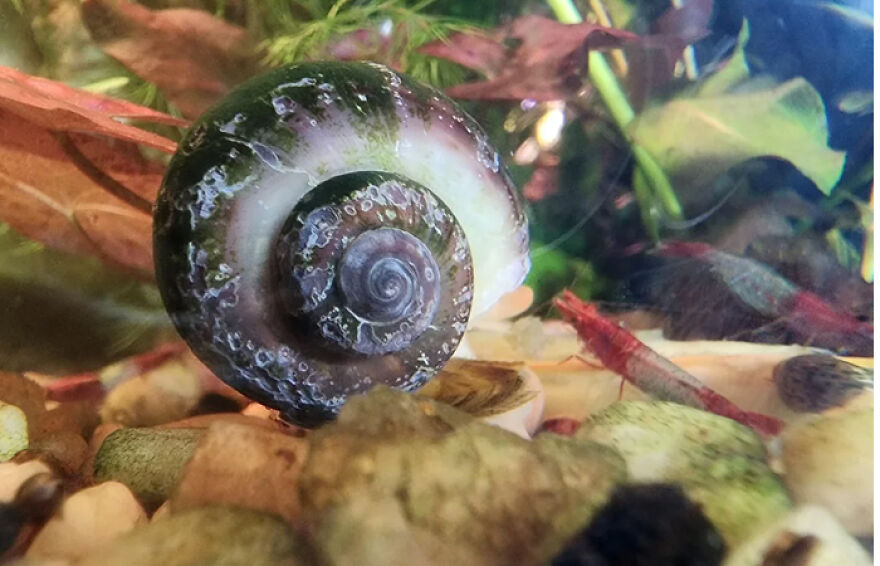The scientific community would have you believe that snails come in many, many different varieties, but there’s a much simpler way to classify them: pesky and not pesky. Your typical garden snail (Cornu aspersum) helps keep the local ecosystem healthy by feeding on decaying matter, but it can also ruin your garden if not managed.
The point is that snails often exhibit both pesky and non-pesky behaviors, and the same applies to the subject of today’s discussion. They are known by many names: Pomacea bridgesii, the gold Inca snail, and the spike-topped apple snail – but for our purposes, the only name that matters is mystery snail.
Enigmatic, unpredictable, and mostly just downright strange, mystery snails make excellent clean-up crews in most tanks, although their behavior can leave you confused and amused at the same time.
They are a totally underrated species, a cult favorite, if you will, and we’re here to tell you all about them.
Why Mystery Snails Make the Best Clean-Up Crew
Mystery snails are among the most unpicky eaters in nature. They’re perfectly happy with leftovers and never hesitate to have a second helping. Their unique appetite and food preferences are exactly what make them so useful for aquarists, like tiny vacuum cleaners that don’t need any help cleaning up the mess left by other fish.

Image credits: r/AquaticSnails
Like vultures and hyenas (though admittedly far less intimidating), mystery snails are scavengers that prefer to eat leftover fish food and decaying plant leaves. They’ll also readily graze on soft algae, though they’re definitely not the fastest eaters! All of this helps keep tanks clean by breaking down potentially foul materials and making the water much clearer overall.
Although mystery snails aren’t always the fastest eaters, they are voracious and sometimes seem insatiable. They’re real go-getters when it comes to food, but will respect the boundaries you set, unlike their larger, more bothersome cousins! Other snails might go after your plants when you’re not looking, but mystery snails will clean those same plants at no extra cost! Now, that’s a cleaning service you can count on!

Image credits: r/AquaticSnails
While they’re not as quick and efficient as, say, nerite snails when it comes to algae, mystery snails maintain their edge through several unique abilities that make them even better at their jobs! For one, mystery snails can breathe both in and out of water thanks to a set of lungs and gills.
They can float upwards by holding air in, and “parasnail” down by expelling that air. This makes them extremely mobile, which is perfect for aquarists because you can always count on a mystery snail to go where the food takes them! Of course, none of this should be new to most aquarists.
Mystery snails have been a popular aquarium pet for a while now, and more and more people are beginning to understand and appreciate the benefits of having a few in the tank!
When Cleaning Goes Off Script
You might be curious at this point: why are mystery snails called mystery snails? The answer, surprisingly enough, is quite mysterious itself! Their scientific name, Pomacea bridgesii, isn’t exactly the clearest title, especially considering the often seemingly unpredictable behavior of the mystery snail.
For starters, unlike many other aquatic snails, mystery snails lay their eggs above the water to protect them from potential predators.
You’ll hardly ever see this, though, but their eggs look like common tank debris, which often confuses owners when new snails appear later. Some owners have even accidentally “walked in” on their snails… in the middle of romance, as shown in this YouTube short.

Image credits: r/AquaticSnails
This is where the “mystery” comes in. Despite the scientific world’s fairly thorough understanding of them, mystery snails still remain completely enigmatic to new owners and even to some professional aquarists who may have never dealt with them before! Their reproductive habits aren’t the only thing that makes mystery snails strange, though.
They’re also amateur magicians and escape artists! It’s not unusual for them to go missing for weeks at a time. You might, in fact, be upset at their apparent death, left wondering what on earth could have caused them to simply disappear. Then, out of nowhere, they reappear as if nothing happened at all! There are several possible reasons for this disappearing act.
First, mystery snails are naturally curious and often explore some… unexpected corners and hiding spots in your tank. They can burrow pretty deep (as one forum user observed), with their shells blending into their surroundings.
Second, mystery snails hibernate for long periods and will find the most obscure, out-of-the-way spots in your tank to rest for a while.
Other behaviors, such as their “parasnailing” technique (as shown in that viral TikTok), or when they accidentally rearrange your plant decor while exploring (like this snail on Reddit), all add to the charm of these quirky little creatures and only deepen the mystery surrounding them (at least for the casual observer)!
When the Clean-Up Crew Creates Headaches
Of course, like all creatures in your care, owning mystery snails comes with its own unique challenges. While they’re not as high-maintenance as some other aquatic species and are great at keeping your tank healthy, mystery snails can occasionally get out of hand.
Let’s start with the basics. Mystery snails can survive in various hard water environments. Ensure that they receive sufficient calcium to help them develop strong shells, and maintain a temperature between 70°F and 78°F with a pH of at least 7.2. It’s also important to note that, like most snails, mystery snails are sensitive to salt, so avoid adding salt to your tank!
A common issue with mystery snails is overpopulation. As mentioned earlier, they sometimes unexpectedly disappear from their usual spot and lay eggs at the top of the tank. New owners might be surprised when, seemingly overnight, they find themselves caring for several new snails.
Fortunately, controlling the mystery snail population is straightforward. If you’re a first-time owner, start with just one mystery snail, preferably a male. Females can store sperm for a long time, so even if they are alone, they may have laid eggs before.
If you have multiple snails, you can prevent breeding by keeping the water level within approximately 15 inches of the tank’s top. This leaves no room for egg-laying.
Some snails are quite clever and may lay eggs on the tank lid. Be vigilant – regularly check for egg clusters and remove them when necessary.
Keep floating plants in floating containers, as mystery snails generally don’t eat plants. However, they do seem to enjoy duckweed, so keep yours out of reach if you have any. Regarding other aquatic life, mystery snails are compatible with many fish that can thrive in similar water conditions, including calmer betta fish.
However, beware of fish that might nibble on the snail’s antennae, which look like tiny worms. Also, keep snail-eaters like pufferfish and turtles well away to protect your mystery snails.
Overall, mystery snails are pretty self-sufficient. Just provide them with some protein and calcium every two to three days, and they’ll be very happy.

Image credits: r/AquaticSnails
FAQ
Are mystery snails good for your tank?
Mystery snails are among nature’s most efficient cleaners and can help you maintain your tank when properly cared for. The only times they can be “bad” for your tank are when they become overpopulated or when you have many floating plants.
Why are mystery snails a problem?
They usually aren’t! Mystery snails only become a problem if they are allowed to breed without supervision. They are also known to eat duckweed and other floating plants.
Can a mystery snail live with a betta?
Mystery snails are very friendly little creatures that can live peacefully with almost any fish. However, when it comes to bettas, you should make sure the betta is fairly calm and gentle – aggressive bettas may nip at your mystery snail’s antennae, which could cause it to retreat and possibly die from starvation.
Why are they called mystery snails?
Mystery snails earn their name from the mysterious ways they behave. They sometimes disappear for weeks and then unexpectedly reappear with their own offspring. They also act oddly at times, such as when they accidentally uproot new plants in their single-minded hunger for food or when they “parasnail” down from the surface of the water, like a video game ragdoll!
 Follow Us
Follow Us





